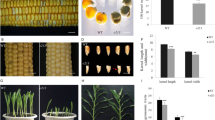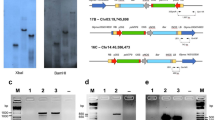Summary
Two new soybean [Glycine max (L.) Merr. cv. Williams] loci, designated Eu2 and Eu3, were identified in which ethyl methanesulfonate (EMS)-induced mutation eliminated urease activity. These loci showed no linkage to each other or to the “Sun-Eul” locus described in the accompanying paper (Meyer-Bothling and Polacco 1987). Unlike sun (seed urease-null) mutations those at Eu2 and Eu3 affected both urease isozymes: the embryo-specific (seed) and the ubiquitous (leaf) urease. The eu2/eu2 mutant had no leaf activity and 0.6% normal seed activity. Two mutant Eu3 alleles were recovered, eu3-e1 and Eu3-e3. The eu3-e1/eu3-e1 genotype lacked both activities while Eu3-e3/Eu3-e3 had coordinately reduced leaf (0.1%) and seed (0.1%) activities. Only the Eu3-e3 mutation showed partial dominance, yielding about 5%–10% normal activity for each urease in the heterozygous state. Each homozygous mutant contained normal levels of embryo-specific urease mRNA and protein subunit, both of normal size. However, urease polymerization was aberrant in all three mutants. In all cases where urease could be measured, it was found to be temperature sensitive and, in addition, the embryospecific urease of Eu3-e3/Eu3-e3 had an altered pH dependence. These mutants may be defective in a urease maturation function common to both isozymes as suggested by the normal levels of urease gene product, coordinately (or nearly so) reduced urease isozyme activities, temperature sensitivity in both ureases (Eu3-e3) and the non-linkage of Eu2 and Eu3 to the locus encoding embryo-specific urease (Sun-Eul). Ubiquitous urease activity is reduced in mutant seed coat and callus culture as well as in leaf and cotyledon tissue. No mutant callus utilized urea (5 to 10 nM) as sole nitrogen source. However, all mutant cell lines tolerated normally toxic levels of urea (25 to 250 mM) added to medium containing KNO3/NH4NO3 as nitrogen source. Urea thus may be used in cell culture as a selection agent for phenotypes either lacking or regaining an active ubiquitous urease.
Similar content being viewed by others
References
Faye L, Greenwood JS, Chrispeels MS (1986) Urease in Jack-bean (Canavalia ensiformis [L.] DC) seeds is a cytosolic protein. Planta 168:579–585
Gamborg OL, Shyluk JP (1970) The culture of plant cells with ammonium salts as sole nitrogen source. Plant Physiol 45:598–600
Hogan ME, Swift IE, Done J (1982) Urease assay and ammonia release from leaf tissue. Phytochem 22:663–667
Kloth RH, Polacco JC, Hymowitz T (1987) The inheritance of a urease null trait in soybean. Theor App Genet 73:410–418
Krueger RW, Holland MA, Chisholm D, Polacco JC (1987) Recovery of a soybean urease genomic clone by sequential library screening with two synthetic oligonucleotides. Gene 54:41–50
Mamiya C, Takishima K, Masakuni T, Ogawa K, Sekita T (1985) Complete amino acid sequence of Jackbean urease. Proc Jpn Acad 61B:395–398
Meyer-Bothling LE (1986) Soybean mutants aberrant in urease expression. Masters Thesis, University of Missouri, Columbia
Meyer-Bothling LE, Polacco JC (1987) Mutational analysis of the embryo-specific urease locus of soybean. Mol Gen Genet 209:439–444
Murashige T, Skoog F (1962) A revised medium for rapid growth and bioassays with tobacco tissue cultures. Physiol Plant 15:473–497
Polacco JC (1976) Nitrogen metabolism in soybean tissue culture. J Assimilation of urea. Plant Physiol 58:350–357
Polacco JC (1977) Nitrogen metabolism in soybean tissue culture. II. Urea utilization and urease synthesis require Ni2+. Plant Physiol 59:827–830
Polacco JC, Havir EA (1979) Comparison of soybean urease isolated from seed and tissue culture. J Biol Chem 254:1707–1715
Polacco JC, Winkler RG (1984) Soybean leaf urease: A seed enzyme? Plant Physiol 74:800–803
Polacco JC, Thomas AL, Bledsoe PJ (1982) A soybean seed ureasenull produces urease in cell culture. Plant Physiol 69:1233–1240
Polacco JC, Krueger RW, Winkler RG (1985) Structure and possible ureide degrading function of the ubiquitous urease of soybean. Plant Physiol 79:794–800
Ryan SA, Harper JE (1983) Mutagenesis of soybeans. Soybean Genet Newslett 10:29–32
Start WG, Ma Y, Polacco JC, Hildebrand DF, Freyer GA, Altschuler M (1986) Two soybean seed lipoxygenase nulls accumulate reduced levels of lipoxygenase transcripts. Plant Mol Biol 7:11–23
Towbin H, Staehelin T, Gordon J (1979) Electrophoretic transfer of proteins from polyacrylamide gels to nitrocellulose sheets: procedure and applications. Proc Natl Acad Sci USA 76:4350–4354
Winkler RG, Polacco JC, Eskew DL, Welch RM (1983) Nickel is not required for apourease synthesis in soybean seeds. Plant Physiol 72:262–263
Author information
Authors and Affiliations
Additional information
Communicated by R.B. Goldberg
Rights and permissions
About this article
Cite this article
Meyer-Bothling, L.E., Polacco, J.C. & Cianzio, S.R. Pleiotropic soybean mutants defective in both urease isozymes. Mol Gen Genet 209, 432–438 (1987). https://doi.org/10.1007/BF00331146
Received:
Issue Date:
DOI: https://doi.org/10.1007/BF00331146




